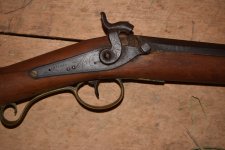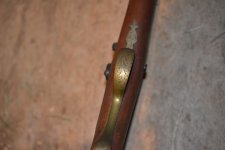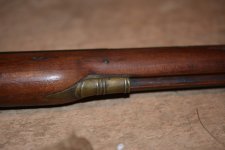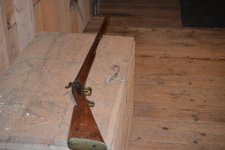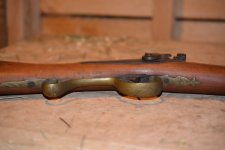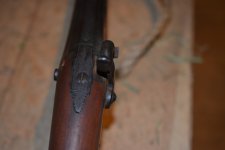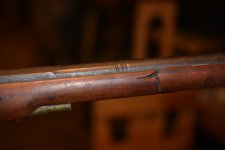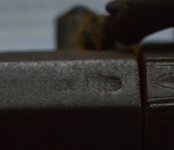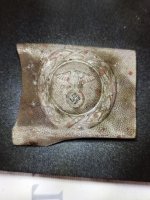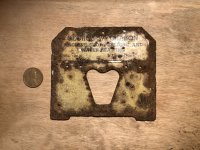You are using an out of date browser. It may not display this or other websites correctly.
You should upgrade or use an alternative browser.
You should upgrade or use an alternative browser.
✅ SOLVED .69 Caliber Musket Identification
- Thread starter coinman123
- Start date
coinman123
Silver Member
- Thread starter
- #41
I don't see anything about the lock, stock, or brass fittings that tells me those parts haven't always been together. I don't think anything on it has been replaced.
As to the barrel... It's entirely possible that when this gun was built the gunsmith reused an old barrel and built a modern (at the time) gun with it. Gun barrels were expensive, and it would just make good sense to reuse one that was still in good shape rather than to scrap it and buy a brand new one. It doesn't bother me at all to think the barrel started out on an older flintlock that someone wanted upgraded, that was a pretty common practice.
Thanks! Someone else said that in the other forum. I'm going to mark this one solved for now. Mid 1800's fowling muzzleloader, with lock made by J. Bishop, and older barrel.
"Johnny has summarised this gun very well. It has most likely been put together probably in the late 1840s to late 50s using inexpensive components coupled with an earlier barrel. The "nipple & drum" percussion adaption was a cost effective method of converting a flintlock barrel to percussion, usually seen in America, & I suspect that this gun has been "made" in that country."
Amazon Forum Fav 👍
Upvote
0
coinman123
Silver Member
- Thread starter
- #42
Upvote
0
BosnMate
Gold Member
- Sep 10, 2010
- 6,916
- 8,441
- Detector(s) used
- Whites MXT, Whites DFX, Whites 6000 Di Pro
- Primary Interest:
- Other
The mark is called a proof mark, which means at least the barrel, if not the entire gun was built probably either in Belgium or England. Google this ---antique firearms proof marks --- and you will get loads of information. If you can compare the proof mark on your gun with one of the many proof marks you will find in your research, many of your questions will be answered. Regarding who ever is saying your gun has been converted from flint, the lock mechanism has to be inlet into the wood. That means wood was cut away, and I see no evidence of that. I would like who ever is saying that your gun is converted from flint lock, to show me a picture of a back action flint lock that was used on anything.
Upvote
0
coinman123
Silver Member
- Thread starter
- #44
The mark is called a proof mark, which means at least the barrel, if not the entire gun was built probably either in Belgium or England. Google this ---antique firearms proof marks --- and you will get loads of information. If you can compare the proof mark on your gun with one of the many proof marks you will find in your research, many of your questions will be answered. Regarding who ever is saying your gun has been converted from flint, the lock mechanism has to be inlet into the wood. That means wood was cut away, and I see no evidence of that. I would like who ever is saying that your gun is converted from flint lock, to show me a picture of a back action flint lock that was used on anything.
Thanks! I will look into that! They said that the barrel was off of an old flintlock, converted into percussion, then put on my gun to save the money of using a new barrel. Does that sound possible? I will look up proof marks, maybe that will solve something!
Upvote
0
NOLA_Ken
Gold Member
- Jan 4, 2011
- 5,214
- 4,178
- Detector(s) used
- several, mostly Garrett
- Primary Interest:
- All Treasure Hunting
Unfortunately I can't match the proofmark to any of the lists I know of offhand, it's just a bit too worn.
There are some "back action" flintlocks.... but they are considerably different from yours as far as the shape of the lock plate. A flintlock will have a frizzen and spring on it, and yours has no place for those to mount, and no patch work on the stock to indicate that part of the lock was missing.
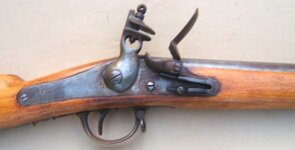 This is a "back action" flintlock, the term mainly refers to the mainspring being behind the hammer, but you can see it's quite a bit different from yours
This is a "back action" flintlock, the term mainly refers to the mainspring being behind the hammer, but you can see it's quite a bit different from yours
There are some "back action" flintlocks.... but they are considerably different from yours as far as the shape of the lock plate. A flintlock will have a frizzen and spring on it, and yours has no place for those to mount, and no patch work on the stock to indicate that part of the lock was missing.
 This is a "back action" flintlock, the term mainly refers to the mainspring being behind the hammer, but you can see it's quite a bit different from yours
This is a "back action" flintlock, the term mainly refers to the mainspring being behind the hammer, but you can see it's quite a bit different from yours
Upvote
0
Top Member Reactions
-
 1974
1974 -
 1165
1165 -
 1123
1123 -
 979
979 -
 963
963 -
 943
943 -
 870
870 -
 806
806 -
 797
797 -
 749
749 -
 454
454 -
 452
452 -
 396
396 -
E
355
-
 335
335 -
 328
328 -
 315
315 -
 301
301 -
 290
290 -
 289
289
Users who are viewing this thread
Total: 2 (members: 0, guests: 2)
